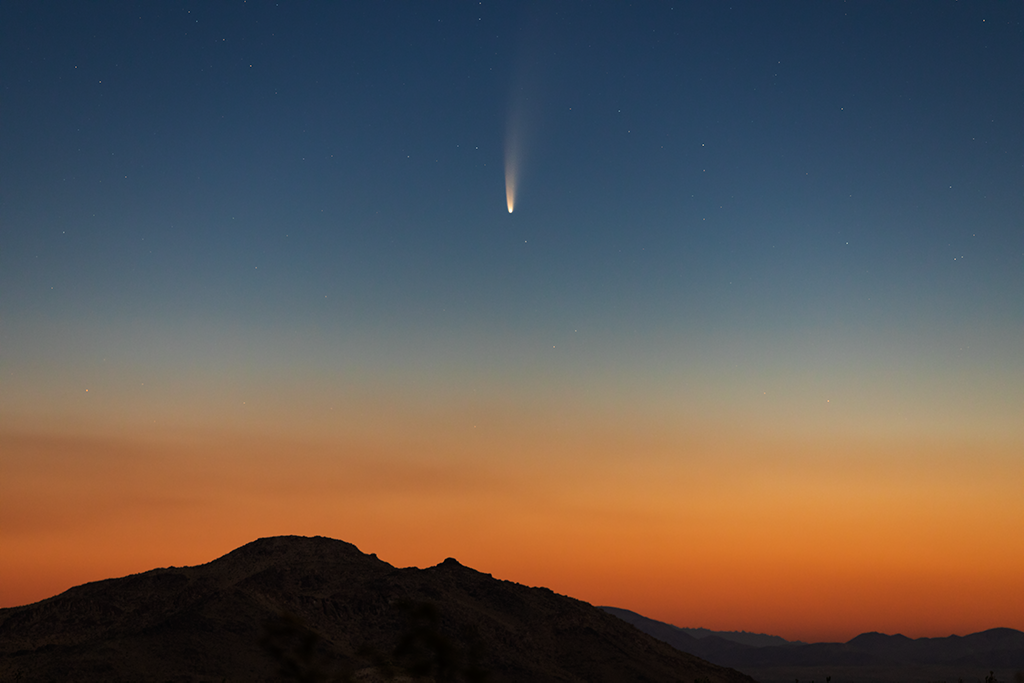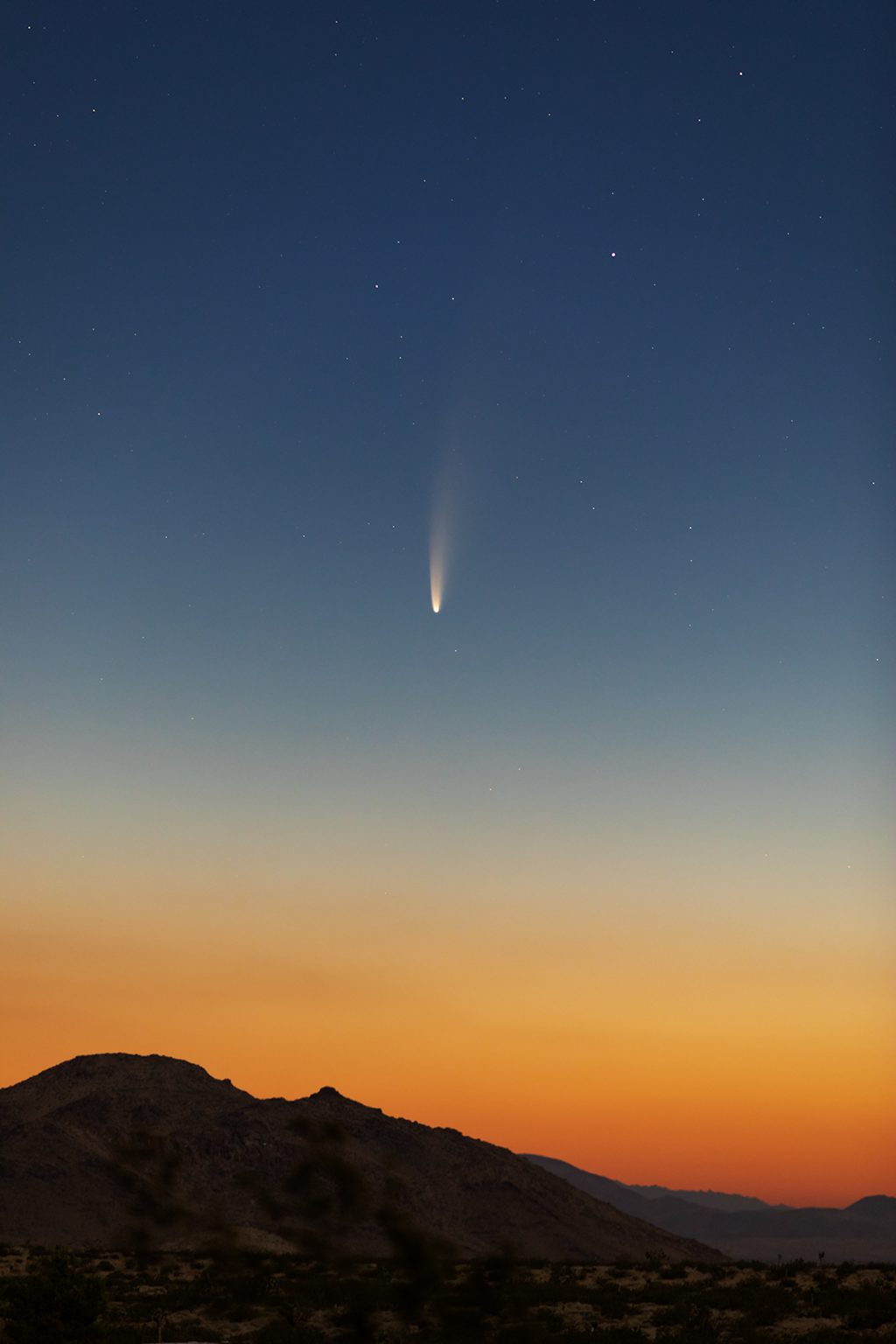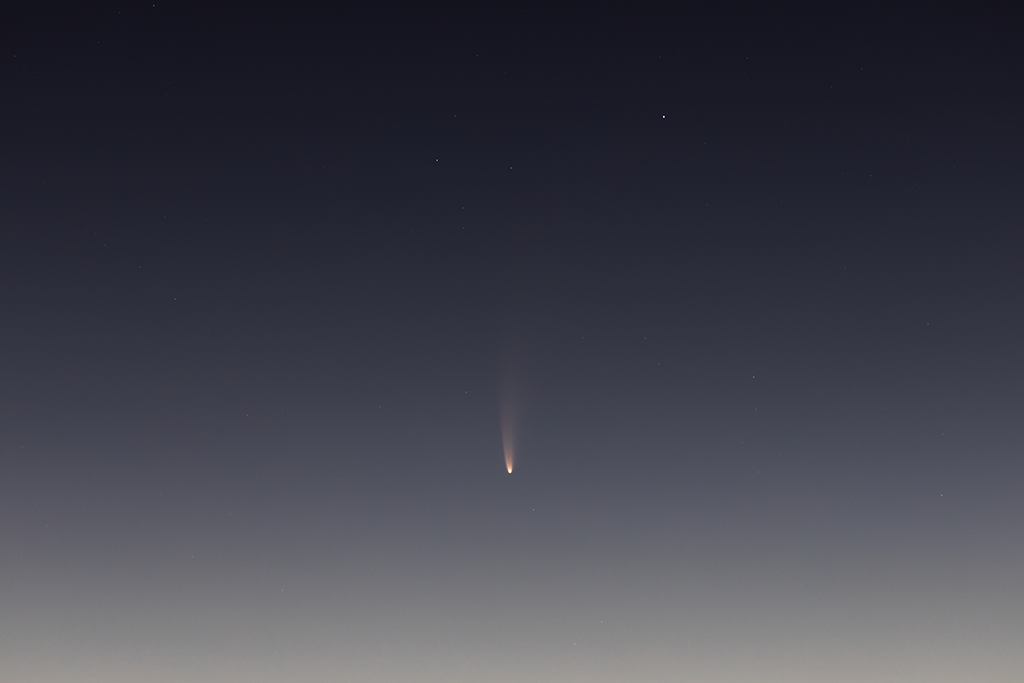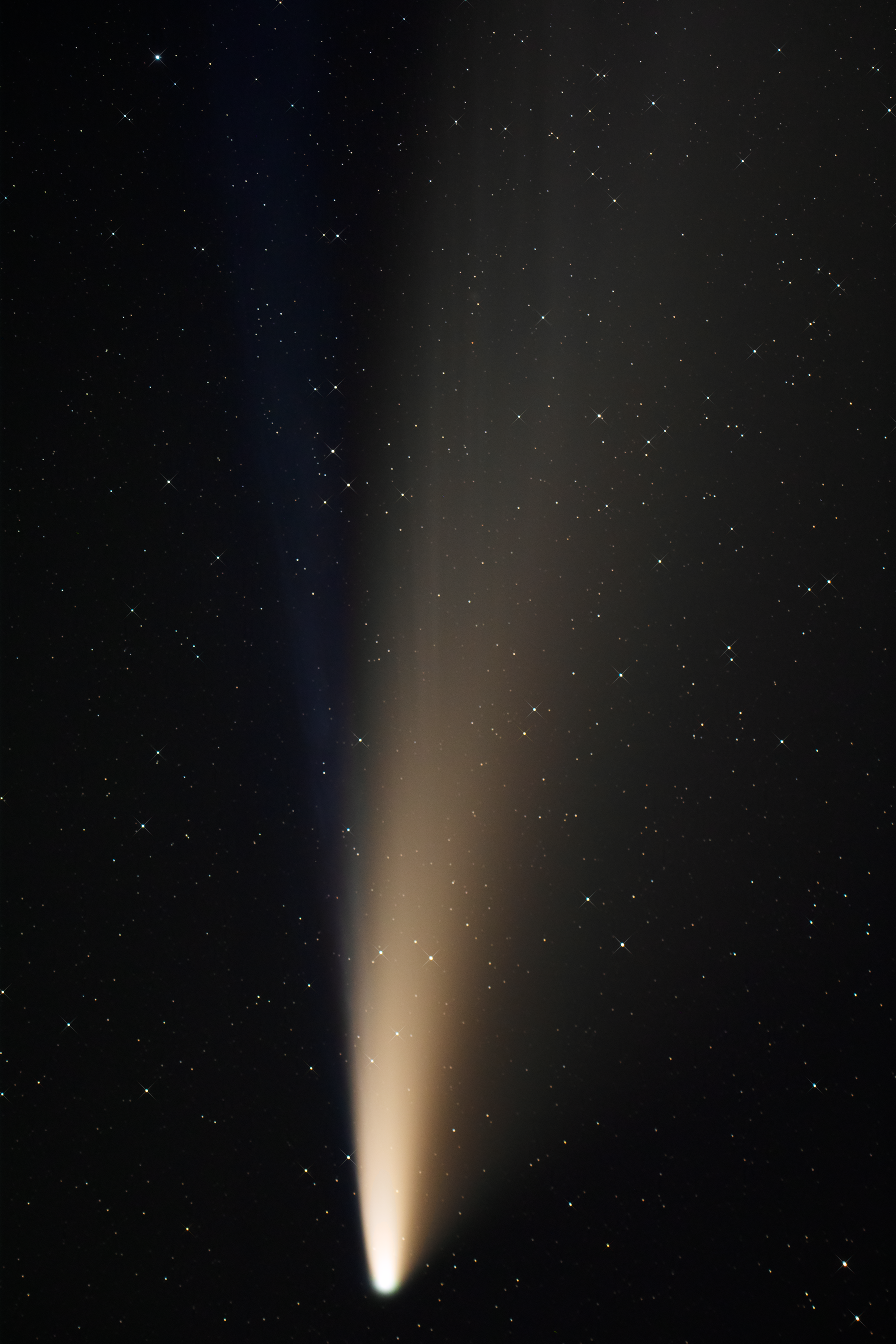Comets are a funny bunch. They aren't as rocky or metallic as asteroids. They aren't shooting stars or meteors. They don't streak across the sky in the blink of an eye. When we see them in the sky, they aren't all that close to Earth (by meteoric standards). But asteroids, meteors, and comets are all related. They are all remnants of the formation of the solar system.
 |
| Comet C/2020 F3 NEOWISE on the morning of July 7, 2020, over Landers, California. Photo by the author. |
Asteroids generally congregate in the Asteroid Belt between Mars and Jupiter. But they can be found outside the asteroid belt also. There are two large groups of asteroids known as Trojans that share an orbital path with Jupiter. The same space telescope responsible for discovering the comet pictured above also recently discovered asteroids sharing Earth's orbit. And there are numerous other asteroids in our solar system that aren't in the Asteroid Belt or in a planet's orbit. Asteroids are rocky and/or metallic and range from groupings of moderately compacted material to large, nearly solid rocks. They are essentially dry, containing little moisture, if any at all. With such a huge amount of large, medium, small, and tiny asteroids orbiting in the narrow path between Mars and Jupiter (and getting shuttled and jostled around by the gravity of those two planets), they sometimes collide with each other or influence each other's orbits and get knocked out of the Asteroid Belt. They can sometimes come relatively close to Earth, at which point they get the additional name of NEO or Near Earth Object. But because of their lack of ice and trapped gasses, they don't produce prominent tails like comets do, even if they get close to the Sun.
Comets, on the other hand, are generally quite loose collections of material, mostly ice (typically water, carbon dioxide, ammonia, and methane), rock, dirt, and dust. Comets typically occupy areas of the solar system much further out from the Sun than asteroids. These areas, the Kuiper Belt and the Oort Cloud, contain innumerable chunks of space debris ranging in size from dust granules to miles-wide icy rocks. Just like asteroids, they can influence each other's orbits or collide, sending a chunk toward the inner solar system. When a comet gets jostled out of its orbit in the Kuiper Belt or the Oort Cloud and approaches the Sun, that ice, dirt and dust heat up. The ice sublimates to gas and, along with the dirt and dust, get swept away from the main body of the comet (the nucleus) and forms a cloud of material around it (the coma). The once frozen ice, now a gas, gets pushed away from the comet's surface by solar pressure and it then reflects sunlight. That's what we see as a comet's tail (often a dust tail and a gas tail that trail the comet's head at slightly different angles because of their density and how they interact with the solar wind). A comet's tail does not indicate its direction of travel. The tail is getting pushed away from the nucleus by the solar "wind," so the tail(s) contra-indicates the position of the Sun relative to the comet's tail. If the tail is pointing up, just follow the tail in the opposite direction like an arrow toward the head of the comet and you'll find the Sun (of course, the Sun will be below the horizon while you're viewing the comet). Comets and asteroids both formed as "left overs" from when the solar system coalesced approximately 4.6 billion years ago. The Sun and planets took up most of the material but fragments of rock, dirt, dust, and ice were left behind. They eventually got pushed around and organized into belts and clouds by the gravity of the larger bodies.
Comets, on the other hand, are generally quite loose collections of material, mostly ice (typically water, carbon dioxide, ammonia, and methane), rock, dirt, and dust. Comets typically occupy areas of the solar system much further out from the Sun than asteroids. These areas, the Kuiper Belt and the Oort Cloud, contain innumerable chunks of space debris ranging in size from dust granules to miles-wide icy rocks. Just like asteroids, they can influence each other's orbits or collide, sending a chunk toward the inner solar system. When a comet gets jostled out of its orbit in the Kuiper Belt or the Oort Cloud and approaches the Sun, that ice, dirt and dust heat up. The ice sublimates to gas and, along with the dirt and dust, get swept away from the main body of the comet (the nucleus) and forms a cloud of material around it (the coma). The once frozen ice, now a gas, gets pushed away from the comet's surface by solar pressure and it then reflects sunlight. That's what we see as a comet's tail (often a dust tail and a gas tail that trail the comet's head at slightly different angles because of their density and how they interact with the solar wind). A comet's tail does not indicate its direction of travel. The tail is getting pushed away from the nucleus by the solar "wind," so the tail(s) contra-indicates the position of the Sun relative to the comet's tail. If the tail is pointing up, just follow the tail in the opposite direction like an arrow toward the head of the comet and you'll find the Sun (of course, the Sun will be below the horizon while you're viewing the comet). Comets and asteroids both formed as "left overs" from when the solar system coalesced approximately 4.6 billion years ago. The Sun and planets took up most of the material but fragments of rock, dirt, dust, and ice were left behind. They eventually got pushed around and organized into belts and clouds by the gravity of the larger bodies.
 |
| This and the previous photo were taken using a Canon EOS 5D Mark IV camera and a Canon EF 200mm f/2.8L lens at f/3.2 using a 3.2-second exposure at ISO1250. |
Meteors... where do they fit in? Meteors and meteor showers are actually remnants of a comet's dust tail! Remember how comets shed material when they come close to the Sun? That material remains in space and leaves a trail. If the Earth passes through that trail, those tiny particles slam into the Earth's atmosphere and burn up. We see them as shooting stars... a speck of dirt about the size of a grain of sand up to a small pebble burning up in the friction created when it hits the resistance of Earth's atmosphere. Each annual meteor shower is associated with a specific comet. See a list of meteor showers and their related comets here.
Historically, comets have been discovered by professional and amateur astronomers. Discoveries were often intentional in that the astronomer set out to discover previously unknown comets, and some were completely accidental, being noticed while the observer was targeting a different object. Comets Halley, West, Shoemaker-Levy, Hale-Bopp, Lovejoy, McNaught, and many, many others are named for the discoverer(s). The well-known astronomer Charles Messier was actually a comet hunter. His list of 110 deep sky objects that later became standard targets for any amateur astronomer actually began as a list of objects that Messier identified so he and other astronomers wouldn't confuse them with comets during their observations. It was as if to say, "Hey, astronomers who are looking for comets... see that blurry patch of sky in Andromeda that kinda looks like a comet? It's not. It's M31 in my catalog. So, move along and keep looking." Messier didn't realize at the time that M31 was an entirely separate galaxy, the Andromeda Galaxy, a couple million light years outside the Milky Way Galaxy (but that's another topic... get more info in this blog article).
More recently, there have been automated missions that scan the skies (for a few different reasons) more quickly and efficiently than any human ever could. These are robotic telescopes with sensitive cameras that scan the sky each night. Some of the missions scan the sky in wavelengths of light other than our normal visible light spectrum. Viewing the solar system and universe in ultraviolet, gamma, x-ray, or infrared lets us discover things that we can't see in normal light. Viewing the sky in infrared is especially useful because it allows us to see through molecular dust clouds to discover stars, star clusters, and galaxies that are normally hidden from our view. The image data from these instruments is then sent through computer software that automatically searches for previously unknown objects. Because of their sensitivity, their ability to scan large patches of sky, and their ability to work autonomously whenever conditions allow, these robotic telescopes are discovering asteroids and comets much more frequently than humans are. That's why a lot of comets today contain names like Pan-STARRS, LINEAR, NEAT, ATLAS, and NEOWISE to name a few. These are the acronyms of the robotic missions. Pan-STARRS for Panoramic Survey Telescope And Rapid Response System, for example. Some are space telescopes, like NEOWISE, while others are ground-based, like Pan-STARRS.
 |
| As the sky brightened in the early morning hours, the contrast required to view the comet against the background sky was fading. Same camera and lens as above. 5-second exposure at f/4.0 and ISO100. |
The NEOWISE mission is somewhat unique because its original purpose was to scan the sky in infrared to catalog more asteroids in our asteroid belt, and to search for galaxies, black holes, and dim stars that were obscured by interstellar dust. (It was originally known as WISE: Widefield Infrared Survey Explorer.) In 2011, with its original mission completed, NASA told the spacecraft and instruments to go to sleep. Two years later, NASA fired it up again so that it could be repurposed to look for Near Earth Objects (NEOs), things like asteroids (that aren't in the Asteroid Belt) and comets that might someday threaten Earth with a collision. Under its new mission, it became known as NEOWISE. It discovered what would become comet C/2020 F3 on March 27, 2020.
 |
| Comet NEOWISE through a Takahashi FSQ-106EDX-III telescope in the evening on 7/15/2020. Visit californiastars.net for photo details. |
However they get discovered, comets can be amazing sights to see... or they can be faint, fuzzy blobs in the sky that won't impress most people. It all depends on the makeup of the comet, it's size, density, and what happens when it approaches the Sun. Some go straight into the Sun and are never seen again. Some get flung out of the solar system. Some get too close to the Sun and break up into multiple pieces. But sometimes, a comet goes around the Sun at just the right speed and distance such that it gets to stay in the solar system, it doesn't disintegrate, it heats up, its ice sublimates, a large bright tail forms, and Earthlings get to enjoy a spectacular show for several weeks.
 |
| Comet NEOWISE through a Meade 10" LX200GPS telescope with Canon EOS 5D Mark IV camera. Five 10-second exposures combined. Image taken on 7/22/2020 from light-polluted Ontario, California. |
Final thoughts and updates: Comet NEOWISE will go down in history as one of the great comets... maybe not quite as spectacular as other great comets like West, Halley, Hale-Bopp, or McNaught but still very impressive. It was easily visible to the naked eye for roughly 2 weeks and was beautiful photographically and through binoculars for several weeks. As of July 25th, the comet's tail became less bright and more difficult to see with the unaided eye. It remains a worthy binocular and telescopic target as of July 28th.
Comments
Post a Comment